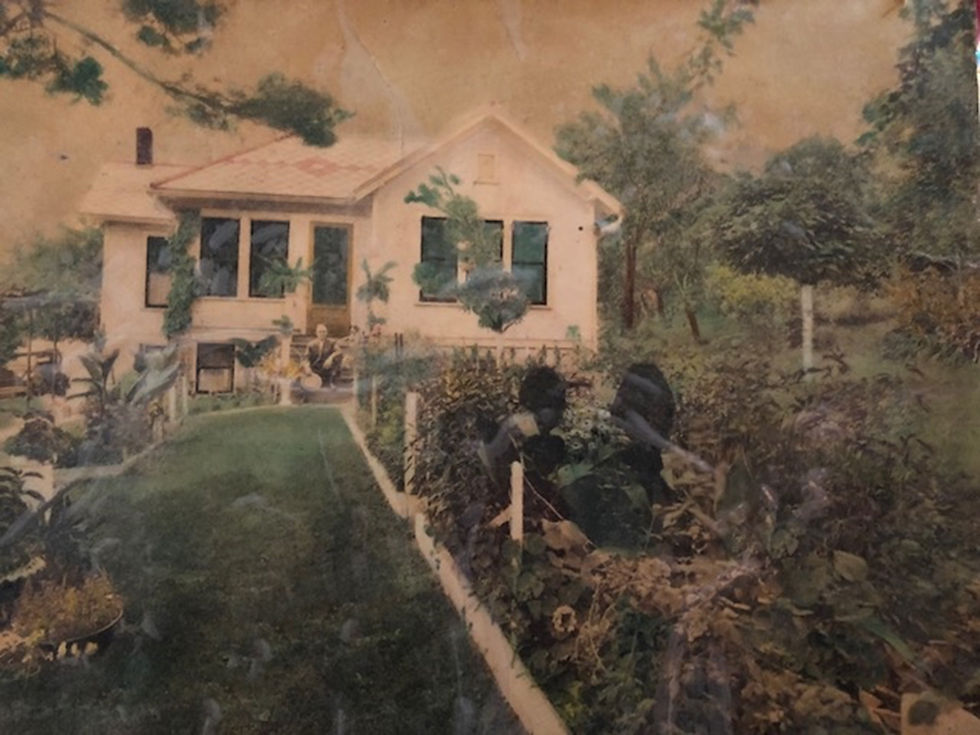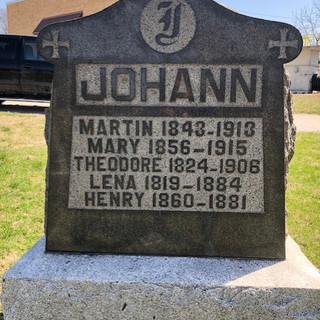Mid-town farm: Johann family keeps ag legacy alive 150+ years
- Mary Lou Montgomery
- Apr 14, 2018
- 5 min read

Frank Johann is pictured in front of his long-time home at 1921 Pleasant Street. Note that brick has replaced the early white siding on the house. Also note the rock wall in front of the house, adjoining Pleasant Street. When this wall began to crumble, it was replaced with railroad ties. Note that Johann is pictured with crutches. JOHANN FAMILY PHOTO/SUSAN TOURNEY

Frank Johann is pictured in front of the family home at 1921 Pleasant Street, Hannibal, Mo., in 1926. Note the white siding; sometime after this day the house was bricked. Frank, a bachelor, would live in the home until his death in 1958. Notice the pattern on the roof. These tiles with the unique design remain on the roof today. JOHANN FAMILY PHOTO/SUSAN TOURNEY
MARY LOU MONTGOMERY
In 1866, the intersection now known as Country Club Drive and Pleasant Street served as the northwest city limits for the town of Hannibal.
Pleasant Street was known as Paris Road, as it was the route the stagecoaches traveled on their daily trips between Paris, Mo., and Hannibal.
Country Club Drive, beginning at this intersection and proceeding southward, was then known as Hayden Street.
The area was rural; Fry’s fruit farm was near this intersection, which was considered to be the highest point in Hannibal.
In 1866, Theodore Johann, a German by birth and 10-years an American resident, bought a piece of ground from Josiah Hunt, who, just a few months before, had platted Hunt’s Addition, bordered to the north and west by Paris Road and Hayden Street.
The property purchased by Johann consisted of about an acre, fronting on Paris Road, and was described as Lot 22. Johann paid $450 for the property. This was the beginning the Johann ownership of this land, which continues today. Pete Johann, who died last December, had resided at 1921 Pleasant St. (the old Paris Road) since 1960; the property still zoned agricultural, despite its presence in the midst of the town of Hannibal.
Family patriarch
Theodore Johann was born in Germany in 1824, and came to the United States with his wife Magdalene (Allena) in 1852. They brought with them son Martin, who was born in Germany in 1843. A second son, Peter, was born in New York in 1853. They settled for a while in Ohio, were daughter Mary was born in 1856. That same year they moved to Julien, Dubuque, Iowa, where the family members were recorded in the Iowa state census as “Johans.”
The 1871 Hannibal city directory records “Theodore Yohon” as a laborer living in Hannibal’s western suburbs. In 1873, the Hannibal directory lists “Theodore Johanns” as a farmer, residing on the east side of Hayden street. Two years later, “Theodore Johanus,” a farmer, was listed as living on the south side of Paris road, east of the town’s westward city limits.
Two years after that – in 1877 – Theodore purchased the adjoining lot to the west of his original lot. This property - also about an acre – was purchased from Dora Fry et al. This was the corner property at Hayden and Paris road (southeast corner) and was the subdivision’s Lot 23.
Theodore bought an additional lot in July 1877, Lot 21; another acre lot which ran parallel to Lot 22. This gave him a 433-foot frontage on Paris Road.
But he wasn’t finished with his land acquisitions. In 1887, he purchased Lots 18 and Lot 19 from W.C. Foreman, adding two more acres and 219 more feet of Paris Road frontage.
Two farm families
Martin Johann – Theodore’s son – married Margaret Goettler (name spellings vary) the daughter of Melchior and Elizabeth Goettler, who owned a farm across Hayden street, west of the Johann farm. Mr. Goettler was first recorded in Hannibal in the 1859 city directory, where he was a carpenter, residing on the north side of Palmyra Avenue, which was Hannibal’s earliest business district. He had moved to Hannibal’s “western suburbs” by 1871. Martin Johann and Kate Goettler were married by 1873, and lived with the Goettlers on their farm across the road from the Johanns. By 1875, Melchoir Goettler was operating a dairy farm on his property.
An heir is born
The Johanns and Goettlers were officially blended with the birth of Frank Francis Johann on April 19, 1873, born to Martin and Kate Goettler Johann.
But this was an ancestral blending that wouldn’t perpetuate the family.
Kate Goettler Johann (calculated at 15 when her son was born) obtained a divorce from Martin Johann in 1892 at Weld, Colo., and soon thereafter married James Van Payton. They ultimately moved to Yakima, Wash., where Kate died on Jan. 15, 1940 at the age of 82. She was buried at Tahoma Cemetery.
Martin Johann didn’t remarry, and worked in Hannibal as a carpenter. He died Jan. 24, 1913, and is buried at Holy Family Cemetery.
Their son Frank remained in Hannibal, and worked during his lifetime as a butcher. He never married. He moved into the house (still standing) at 1921 Pleasant Street in the 1920s, where he lived for the remainder of his life. He was crippled on his right side, and constructed a personal elevator in the house to lift him from the basement to the first floor. He died on Christmas Eve 1958, at the age of 85, and is buried at Holy Family Cemetery.
Land legacy
Martin Johann’s brother, Peter Johann, married into another prominent German family, the Killians, who conducted a butchering business on Mark Twain Avenue. Henry Andrew Johann was born in 1887 to Peter and Margaret Killian Johann. Henry’s first marriage was in 1914 to Ethel Williams, the daughter of Thomas B. Williams and Hattie Gardner Williams. Ethel died the following year as the result complications of childbirth.
Henry’s second marriage was to Lottie Mae Epley. Their children were:
Henry Johann 1915 (son of Ethel and Henry)
Marceline Johann 1919
Clara Johann 1920
Dorothy Johann 1924
Vivian Johann 1926
Pete E. Johann 1928
Juanita Johann 1931
Alice Johann 1935.
Inheritance
Frank Johann, when he died in 1958, left the family’s Pleasant Street farm to Pete E. Johann, the son of his first cousin, thus keeping this five-acre farm in the Johann family.
In 1960, Pete Johann and his wife, Dorothy Margaret Martin Johann, moved into Frank Johann’s house at 1921 Pleasant St., and raised their five children there. Mrs. Johann died in 2007.
Pete Johann died in December 2017, at age 89, survived by four of his children.

Frank Johann, who lived in this house at 1921 Pleasant Street for more than 30 years, installed a personal elevator from the basement of the home to the first floor, in order to accommodate his disability. Frank Johann died in 1958. JOHANN FAMILY PHOTO/SUSAN TOURNEY

The Johann property, located at 1921 Pleasant St., Hannibal, Mo., has been a familiar Hannibal landmark for many years. A family farm beginning in 1866, the property maintains its agricultural zoning, despite the fact that the town of Hannibal surrounds it. In years past, Pete Johann would graze livestock on the five-acres, and until the last few years, it wasn’t uncommon to see horses grazing on the property. Pete died in December 2017 at the age of 89. He and his wife moved into this house in 1960, and raised their five children here. JOHANN FAMILY PHOTO/SUSAN TOURNEY

These two subdivision plats have been attached to illustrate how the old Paris to Hannibal road followed the same path that Pleasant Street follows today. In the illustration at right, you see the Johann property, parts of which have been in the family continuously since 1866. Martin Johann was married to Kate Goettler, whose family farmed the land illustrated at left. The two properties were divided by Hayden Street, later renamed Country Club Drive. ILLUSTRATION/MARY LOU MONTGOMERY

Peter Johann, grandfather of Pete Johann (who died in December 2017) is pictured in this undated photo. Peter’s family lied at 452 Palmyra Road, which was later renamed Mark Twain Avenue.
https://www.maryloumontgomery.com/single-post/2015/03/15/Inside-these-walls-Kilian-heritage-dates-back-154-years-on-Palmyra-Ave
Note: To read the story of the Killian family, Pete Johann's maternal grandparents whose old house still stands on Mark Twain Avenue, follow this link:
https://www.maryloumontgomery.com/single-post/2015/03/15/Inside-these-walls-Kilian-heritage-dates-back-154-years-on-Palmyra-Ave




































































Comments